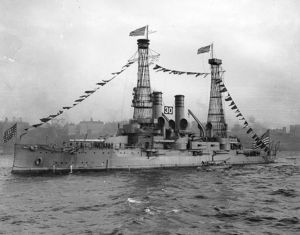Mississippi-Class Battleship
 From Conservapedia
From Conservapedia The Mississippi-class represented the U.S. Navy's final design of what would soon be called "pre-dreadnoughts", battleships with a main battery of two or more different-sized guns. Congressional action limited their displacement, a response to the rising size and cost of battleships that was also justified by the hardy theory that numbers of ships are more important that the quality of individual units. Accordingly, they were smaller, slower and shorter-ranged than their contemporaries, though their armament was similar in power: A pair of 12-inch guns in a turret at each end of the superstructure, 8-inch guns mounted in two twin turrets on each side amidships and four 7-inch guns in casemates on each side of the hull. Operationally, the Navy clearly regarded them as inadequate, a view that undoubtedly encouraged their early disposal.
However, during their early careers, Mississippi and her sister, USS Idaho, underwent the same pattern of modernization as other modern U.S. Navy battleships. Commissioned right at the end of the era of "white and buff" paint schemes, both received new "cage" mainmasts and were repainted overall gray before the end of their first year's service. In 1910, they were fitted with "cage" foremasts in place of the original "military" type, giving them a much more balanced appearance.
In addition to the usual east coast and Caribbean service pattern of most their contemporaries, both ships made a cruise or two to Europe. Mississippi ended her American career as an aviation support ship, the Navy's first of the type, and tended her seaplanes in a pioneering combat role during the 1914 Vera Cruz operation. In July 1914, the two ships were sold to Greece, the only U.S. Navy battleships ever to be transferred to a foreign power. Nearly three decades later, in April 1941, after their active service had ended, they were sunk by German dive bombing attacks. They were the first American-built battleships to be lost to hostile air attack.
The Mississippi-class numbered two ships, both built at the William Cramp & Sons shipyard, Philadelphia, Pennsylvania:
- USS Mississippi (BB-23). Keel laid in May 1904; launched in September 1905; commissioned in February 1908.
- USS Idaho (BB-24). Keel laid in May 1904; launched in December 1905; commissioned in April 1908.
Design characteristics[edit]
- Displacement: 13,000 tons
- Dimensions: 382' (length overall); 77' (extreme beam)
- Powerplant: 10,000 horsepower, triple-expansion reciprocating engines, two propellers, 17 knot maximum speed
- Armament (Main Battery): four 12"/45 guns in two twin turrets; eight 8"/45 guns in four twin turrets (four guns per side); eight 7"/45 guns in single casemate mountings (four guns per side)
- Armament (Secondary Battery): Twelve 3"/50 guns in single mountings.
Ships[edit]
USS Mississippi (BB-23)[edit]
Mississippi was commissioned in February 1908 and spent her first few years of service operating along the U.S. east coast and in the Caribbean area. In addition, in May 1909, the battleship cruised up the Mississippi River to demonstrate contemporary naval technology to the citizens of the south-central United States.
In late 1910, Mississippi steamed across the Atlantic to call on ports in Great Britain and France. She thereafter returned to her normal operating areas in the western Atlantic. In June 1912, she landed U.S. Marines in Cuba to protect U.S. interests. In reserve from mid-1912 until the end of 1913, Mississippi then carried men and equipment to Pensacola, Florida, where she supported the conversion of the old Naval facility there into a naval air station. In April and May 1914, she transported seaplanes and aviators to Vera Cruz, Mexico, and acted as their tender during the Navy's first combat aviation deployment. After further duty at Pensacola, Mississippi was sold to Greece in July 1914. Renamed Kilkis, she served in the Greek Navy until 23 April 1941, when she was sunk by German dive bombers at Salamis.
USS Idaho (BB-24)[edit]
Idaho was commissioned in April 1908. Following operations in the Caribbean area and a period of shipyard work, she took part in the February 1909 naval review at Hampton Roads, Virginia, celebrating the "Great White Fleet"'s return home from its World cruise. Over the next five years, Idaho served with the Atlantic Fleet along the U.S. east coast and in the Caribbean, also participating in the naval reviews that were at that time frequent events at New York City. She also made a voyage to England and France in late 1910 and cruised on the Mississippi River in 1911.
After several months out of commission, Idaho returned to service in May 1914 for a midshipmen's training cruise to the Mediterranean. On 17 July she arrived at Villefranche, France, and transferred her crew to the battleship Maine. Decommissioned on 30 July 1914, USS Idaho was sold to Greece. Renamed Lemnos, she was a unit of the Greek Navy until 23 April 1941. By that time reduced to a hulk, the old ship was sunk in the same attack as her sister.
| Copyright Details | |
|---|---|
| License: | This work is in the Public Domain in the United States because it is a work of the United States Federal Government under the terms of Title 17, Chapter 1, Section 105 of the U.S. Code |
| Source: | File available from the United States Federal Government [1]. |
Categories: [United States Navy] [Battleships] [Warships]
↧ Download as ZWI file | Last modified: 02/28/2023 19:31:50 | 5 views
☰ Source: https://www.conservapedia.com/Mississippi-class_battleship | License: CC BY-SA 3.0
 ZWI signed:
ZWI signed:
 KSF
KSF